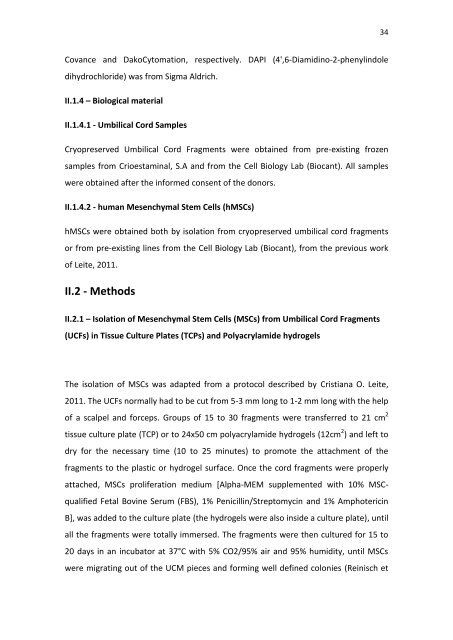DEPARTAMENTO DE CIÊNCIAS DA VIDA ... - Estudo Geral
DEPARTAMENTO DE CIÊNCIAS DA VIDA ... - Estudo Geral
DEPARTAMENTO DE CIÊNCIAS DA VIDA ... - Estudo Geral
You also want an ePaper? Increase the reach of your titles
YUMPU automatically turns print PDFs into web optimized ePapers that Google loves.
34<br />
Covance and DakoCytomation, respectively. <strong>DA</strong>PI (4',6-Diamidino-2-phenylindole<br />
dihydrochloride) was from Sigma Aldrich.<br />
II.1.4 – Biological material<br />
II.1.4.1 - Umbilical Cord Samples<br />
Cryopreserved Umbilical Cord Fragments were obtained from pre-existing frozen<br />
samples from Crioestaminal, S.A and from the Cell Biology Lab (Biocant). All samples<br />
were obtained after the informed consent of the donors.<br />
II.1.4.2 - human Mesenchymal Stem Cells (hMSCs)<br />
hMSCs were obtained both by isolation from cryopreserved umbilical cord fragments<br />
or from pre-existing lines from the Cell Biology Lab (Biocant), from the previous work<br />
of Leite, 2011.<br />
II.2 - Methods<br />
II.2.1 – Isolation of Mesenchymal Stem Cells (MSCs) from Umbilical Cord Fragments<br />
(UCFs) in Tissue Culture Plates (TCPs) and Polyacrylamide hydrogels<br />
The isolation of MSCs was adapted from a protocol described by Cristiana O. Leite,<br />
2011. The UCFs normally had to be cut from 5-3 mm long to 1-2 mm long with the help<br />
of a scalpel and forceps. Groups of 15 to 30 fragments were transferred to 21 cm 2<br />
tissue culture plate (TCP) or to 24x50 cm polyacrylamide hydrogels (12cm 2 ) and left to<br />
dry for the necessary time (10 to 25 minutes) to promote the attachment of the<br />
fragments to the plastic or hydrogel surface. Once the cord fragments were properly<br />
attached, MSCs proliferation medium [Alpha-MEM supplemented with 10% MSCqualified<br />
Fetal Bovine Serum (FBS), 1% Penicillin/Streptomycin and 1% Amphotericin<br />
B], was added to the culture plate (the hydrogels were also inside a culture plate), until<br />
all the fragments were totally immersed. The fragments were then cultured for 15 to<br />
20 days in an incubator at 37°C with 5% CO2/95% air and 95% humidity, until MSCs<br />
were migrating out of the UCM pieces and forming well defined colonies (Reinisch et
















